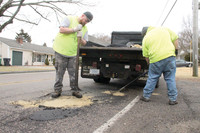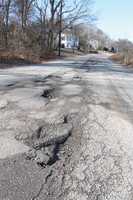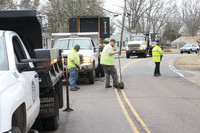By JOHN HOWELL -- You may get a bang out of this time of year. That’s not what city and state crews want, but it seems just as fast as potholes are filled, they open up again.
This item is available in full to subscribers.
We have recently launched a new and improved website. To continue reading, you will need to either log into your subscriber account, or purchase a new subscription.
If you are a current print subscriber, you can set up a free website account by clicking here.
Otherwise, click here to view your options for subscribing.
Please log in to continue |
|



You may get a bang out of this time of year.
That’s not what city and state crews want, but it seems just as fast as potholes are filled, they open up again.
“There’s a lot of them,” said Kenneth Picozzi, highway chief, as he made the rounds Wednesday. Close by, a three-man crew filled potholes on Diamond Hill Road, a process that requires using cold patch, filling the hole, tamping it down and then dusting it with sand in an effort to minimize the cold patch from adhering to tires as vehicles cross the surface.
Picozzi, as well as the crew, including Swav Hermanowski, Chris St. Pierre and Michael Lill, know they could be doing it all over again in a day. Cold patch doesn’t stand up to the effects of rain and the freeze and thaw that happens at this time of year.
“It’s very difficult to stay abreast [of potholes],” said Richard Crenca, director of the Department of Public Works. Crenca called cold patch “unreliable,” adding there’s not much the department can do until asphalt plants reopen in March or April and hot patch is available.
In addition to potholes and the damage they can cause, Crenca is concerned for the safety of those filling them. On Friday, Brian Olivera was hit by a motorist as he and another worker filled potholes on Meadow View Avenue, close to the intersection with Warwick Neck Avenue. Fortunately, Olivera was not seriously injured and was expected to return this week, said Picozzi.
To add a level of protection, each of the two department crews consist of two trucks and three men. The trucks travel in tandem with the first vehicle in the lane of travel transporting a large flashing arrow. The third man keeps an eye on traffic and waves motorists away from the work area.
In past years potholes have been so prevalent that the city set up a pothole hot line for people to file reports. It hasn’t gotten that bad this year, although both the mayor’s office and the Department of Public Works reported a flurry of calls with the first thaw. The numbers to call to report a pothole are 921-9601 and 738-2003. Either number works.
Picozzi estimated the two city crews are filling about 50 potholes a day and that, as of this week, the city has used 50 to 60 tons of cold patch.
“It’s one of those temporary things,” he said of cold patch. He said that once asphalt plants are operating, city crews will return to jack hammer out the holes and make the cuts in the road for a permanent patch.
State Department of Transportation spokesman Charles St. Martin said this year’s volume of potholes is comparable to last year and that, no doubt, “we’re in the pothole season.”
In addition to crews that have access to limited amounts of hot mix asphalt, St. Martin said the state has six pothole patchers. These vehicles that the state contracts have a heated adhesive mix that is sprayed into the pothole before it is filled with a granular mix that hardens.
The state started using two contractors in 2015, and St. Martin said those patches are more resilient than conventional patches.
“We seem to have fewer complaints,” he said.
According to the DOT website, “Pothole patching happens several days a week, but cannot be done during winter storms. During weeks with more than one storm, or during long-duration storms, it may take longer for us to complete pothole repairs.”
The number to call to report a pothole on a state road is 401-222-2450 weekdays from 7:30 a.m. to 4 p.m. Outside these hours, call 401-222-2378.
Comments
No comments on this item Please log in to comment by clicking here